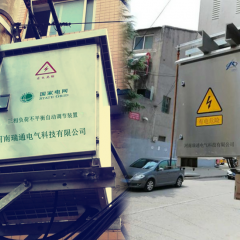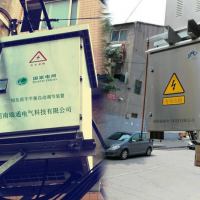Ruitong Electrical Xi'an R&D Center has developed an auto adjustment device for three-phase load imbalance (RT-MEC), a new type of power electronic equipment. By collecting the operation parameters of three-phase voltage and current of the low-voltage distribution line with the sampling circuit, the device can calculate the imbalance extent between the phases and the current value and phase to compensate and be compensated via model operation. It controls the PWM signal generator to send control signals to internal IGBT drive according to the set value, and thus the inverter will generate a required current signal and send into the system, so as to realize the automatic balance adjustment of the three-phase loads.Working Principle Schematic Diagram of Auto Adjusting Device for Three-phase Load Imbalance (RT-MEC).
Product Features:
-The highly-integrated three-level IGBT module from Infineon, Germany, ensures low voltage stress and high reliability, as well as reduced conduction loss and switching loss;
- Adopt TI's TMS320F28377D series DSP chip with dual-core 32-bit CPU, to ensure high control precision and fast speed, and with multiple 16-bit ADCs, to ensure high sampling accuracy;
- Adopt a three-level topology to effectively reduce ripple current and improve the quality of the output waveform;
- Adopt the magnetic ring reactor with small size, light weight, low temperature rise and low noise;
- The high-performance Hall current sensor and Hall voltage sensor ensure high sampling accuracy;
- Various compensation modes: harmonic suppression priority, reactive power compensation priority, active imbalance adjustment priority, etc.;
- The response time is less than 10ms and the control is fast, which ensures better transient stability;
- Complete protection functions for external electrical faults such as busbar overvoltage, undervoltage and phase loss, and internal faults such as IGBT overheating and overcurrent;
- Complete production and inspection procedures, all products undergo 12-step production process, 4 inspection procedures, and 72-hour aging test.
- The WIFI module supports close observation and debugging via mobile phone for equipment operation;
Main technical parameters:
|
Rated capacity |
RT-MEC0.4-30 |
RT-MEC0.4-50 |
RT-MEC0.4-75 |
RT-MEC0.4-100 |
|
System Parameters |
||||
|
Working Voltage |
400V?-40%?+20%? |
|||
|
Operating Frequency |
50/60Hz±5% |
|||
|
Wiring Method |
Three-phase three-wire?Three-phase four-wire |
|||
|
Performance |
||||
|
Compensation Modes
|
8 modes including active imbalance priority and reactive power priority |
|||
|
Imbalance compensation ability |
The imbalance rate within the range of compensation capacity ?3% |
|||
|
Efficiency |
≥97% |
|||
|
Effective response time |
Instant response time <0.1ms?complete response time≤10ms TSC branch response time≤20ms |
|||
|
Protective Function |
Overvoltage?undervoltage ?inverter overcurrent ?overheating?overload ,etc |
|||
|
Display and interface |
||||
|
Language |
Chinese and English interface |
|||
|
Display |
Voltage?Current ?power factor?imbalance rate?harmonic content ,etc |
|||
|
Communication Interface |
Optional between RS-232?RS-485?RJ45 network interface? WIFI and GPRS |
|||
|
Communication Protocol |
MODBUS-RTU |
|||
|
Case Configuration |
||||
|
Profile |
Stainless Steel |
|||
|
Environmental Conditions |
||||
|
IP Level |
IP44? customization is available for other IP levels ? |
|||
|
Operating Temperature |
-10?55? |
|||
|
Storage Temperature |
-25?70? |
|||
|
Relative Humidity |
Maximum 95?RH?no condensation? |
|||
|
Altitude |
No higher than 1500m?higher altitude are supported if the capacity is sightly reduced ? |
|||




